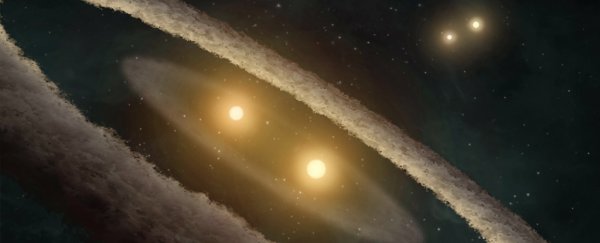The assumption that most, if not all, stars have at least one sibling when they are born is supported by a new model of how stars are created.
It is likely the same for our Sun, which is located in the core of the Solar System. In fact, some scientists speculate that the dinosaurs’ extinction may have been caused by the Sun’s long-lost sibling.

All Sun-like stars are most likely born with a partner, two researchers from UC Berkeley and the Harvard-Smithsonian Astrophysical Observatory concluded in 2017 after analyzing data from a radio scan of a dust cloud in the Perseus constellation.
Steven Stahler, an astronomer from the University of California, Berkeley, stated in June 2017 that “We ran a variety of statistical models to see whether we could explain the relative quantities of young single stars and broad binaries in the Perseus molecular cloud. The results could only be explained by a hypothesis in which all stars originally develop as broad binaries.

Since years, astronomers have debated whether the numerous binary and triple star systems in our galaxy are created near to one another or if they combine after being created.
The “born together” explanation has been widely accepted, and simulations conducted in recent decades have demonstrated that practically all stars might have been created as multiples that frequently drift apart on their own.
This new work is quite interesting because there hasn’t been much real-world evidence to support these simulations.
Our finding is a step toward understanding how binaries originate and what function they serve in the early history of stars, according to Stahler.
The researchers mapped radio waves emanating from a dense cocoon of dust 600 light-years away that included a nursery of newborn stars as part of the VLA nascent disk and multiplicity survey (VANDAM for short).
Stars under half a million years old could be counted thanks to the VANDAM survey. These stars are classified as Class 0 stars, which is astronomical jargon for “babies,” whereas Class 1 stars are those that are between 500,000 and 1 million years old.

The theoretical twin star of our Sun.
Scientists found 45 single stars, 19 systems with two stars, and five systems with more than two stars by looking at the shapes of the dust clouds around them.
Even though their results said that all stars are born as binaries, they changed their conclusion to say that most stars born inside the dense cores of dust clouds are born with a partner. This is because their model had some problems.
“I believe we have the best evidence to date for making such a claim,” Stahler stated at the time.

All of the binaries that were more than 500 AU away were Class 0 and lined up with the center of the egg-shaped cloud that enveloped them, the researchers discovered when they examined the distances between the stars.
In contrast, class 1 stars’ axes weren’t aligned and they were typically 200 AU or closer apart.
“We don’t know precisely what that implies yet,” said Sarah Sadavoy of the Harvard-Smithsonian Astrophysical Observatory, “but it’s not random and must tell something about how wide binaries arise.”
If most stars are born with a partner, where is ours?
0.008 light-years, or little less than 3 light-days, separate 500 AU from Earth. To put this in perspective, Neptune is roughly 30 AU from the sun, the Voyager 1 spacecraft is roughly 140 AU from the sun, and Proxima Centauri, the nearest star to the sun, is roughly 268,770 AU from the sun.
Therefore, if the Sun has a twin, we are unlikely to be able to view it from Earth.
However, there is a hypothesis that suggests our Sun has a twin that occasionally wanders by and stirs things up.
Theoretical troublemaker Nemesis has been blamed for what seems to be a 27-million-year cycle of extinctions on Earth, including the one that killed off most dinosaurs.
Richard Muller, an astronomer at the University of California, Berkeley, suggested 23 years ago that a red dwarf star 1.5 light-years away could sometimes move through the icy outer limits of our Solar System, moving things around with its gravity and sending a few more space rocks our way.
A dim star passing by, like a brown dwarf, could also explain other strange things on the edge of our Solar System, like the dwarf planet Sedna’s wide, strange orbit.
There’s no sign of Nemesis, but our Sun could have a long-lost binary partner.
“We are saying that, yes, Nemesis probably existed a long time ago,” Stahler said.
In that case, it seems like our Sun would have gotten most of the dust and gas, leaving its twin planet dark and small.
So it’s not surprised that it’s a little mad.
This study was published in the Royal Astronomical Society’s Monthly Notices.
Soucre: viralonce.xyz





